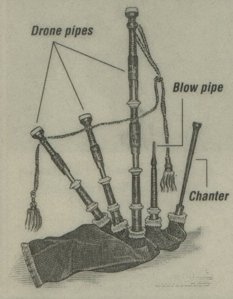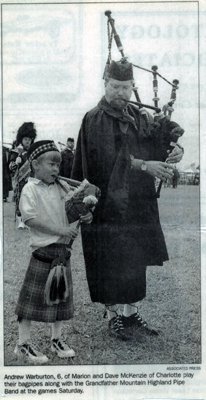The History of Piping
-Reprinted from the Loch Norman Highland Games Program
The Romans may have introduced the pipes to the British Isles during their occupation, but over the centuries, more than any other group, the Scots have adapted and adopted the pipes as an enduring symbol of Scottish Nationalism. The Bagpipe along with the tartan and the kilt were such powerful symbols of Scottish nationalism that they were banned by the English occupation.
The English feared the stirring effect of the pipes on Scottish emotions. Piper James Reid of Prince Charlie's army was executed at York on November 15, 1746 as a rebel. At his trial it was argued in his defense that he had "not carried arms," however, Lord Chief Baron observed that, "a Highland Regiment never marched without a piper... therefore, his bagpipe, in the eyes of the law was an instrument of war."
 It is said that the
great masters of the bagpipes can make the pipes convey nearly every human
emotion, as though the pipes were speaking. For centuries, it was a commonly
held belief that the pipes could talk. Stemming perhaps from the piper's duty to
compose music to commemorate every important occasion. From centuries of
compositions, we have music handed down to us ranging from the mournful to the
exultant.
It is said that the
great masters of the bagpipes can make the pipes convey nearly every human
emotion, as though the pipes were speaking. For centuries, it was a commonly
held belief that the pipes could talk. Stemming perhaps from the piper's duty to
compose music to commemorate every important occasion. From centuries of
compositions, we have music handed down to us ranging from the mournful to the
exultant.
The Great Highland
pipes consist of three drones (one bass and two tenor); a blowpipe with a valve
to prevent the air from coming back out of the bag while the piper is taking a
breath; a chanter with eight finger holes (nine notes), which is conical shaped
inside; and a bag. Each drone has a single reed, a primitive older style, like a
clarinet, and the chanter has a double reed, very similar to that of an oboe. The piper plays by blowing in the blowpipe,
inflating the bag enough to sound the three drones, then placing the bag under
his arm and maintaining enough pressure to sound the chanter, where the melody
is played. Each drone is tuned to "A" on the chanter scale.
similar to that of an oboe. The piper plays by blowing in the blowpipe,
inflating the bag enough to sound the three drones, then placing the bag under
his arm and maintaining enough pressure to sound the chanter, where the melody
is played. Each drone is tuned to "A" on the chanter scale.
Dave believes in passing on the skills of a piper to the next generation.
Pipe Music
There are three general categories of music for the highland bagpipe: Ceol Mor (big music), Ceol Meadhonach (middle music) and Ceol Beag (little music). Ceol Mor is the classical and oldest form of pipe music often referred to today as Piobaireachd (peabrock) "Piobaire" means piper and "eachd" means pipe playing or music. Piobaireachd is the most difficult pipe music to play. Marches, strathspeys, reels, hornpipes, jigs, polkas and retreats are also played on the pipes.

 Pipers are judged on
the following elements. Time, including tempo and breaks between tunes, the
measure of sounds with regard to their duration and the speed of the rhythm.
When more than one tune is being performed, a smooth transition is expected. The
tuning and tone of the chanter and drones. The technical execution of the
various movements and grace notes. And the expression or quality that appeals to
the listener or conveys the sentiments of the composer.
Pipers are judged on
the following elements. Time, including tempo and breaks between tunes, the
measure of sounds with regard to their duration and the speed of the rhythm.
When more than one tune is being performed, a smooth transition is expected. The
tuning and tone of the chanter and drones. The technical execution of the
various movements and grace notes. And the expression or quality that appeals to
the listener or conveys the sentiments of the composer.
Dave is a three time recipient of the MacCrimmon Quaich Award for Excellence in Piobaireachd.
In addition, he has won with an actual MacCrimmon tune each time: The 1st time in 1998 with “A Flame of Wrath for Squinting Patrick” and two subsequent times in 2001 and 2002 with “MacCrimmon’s Sweetheart.”